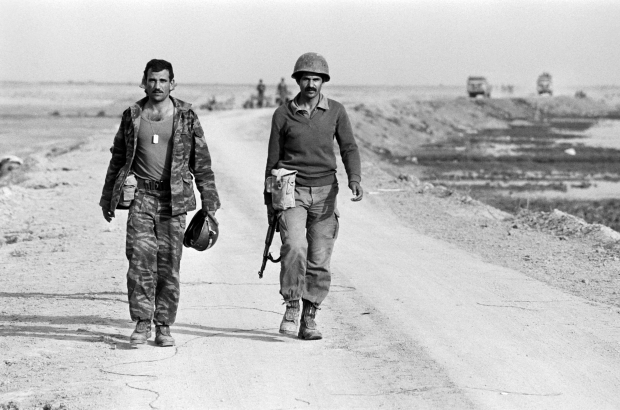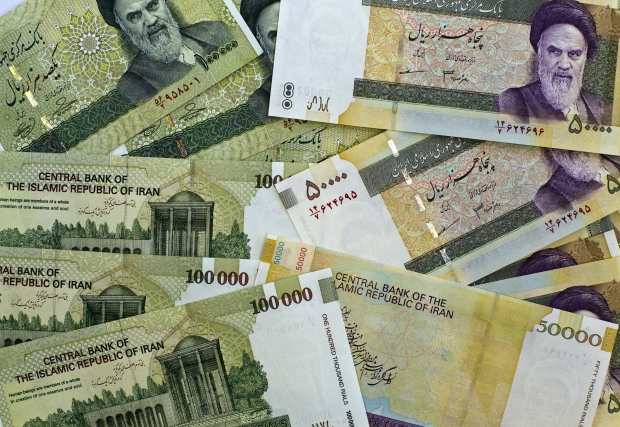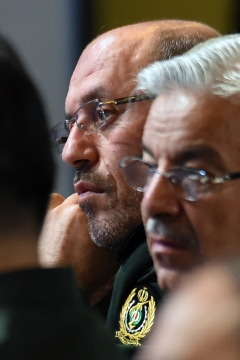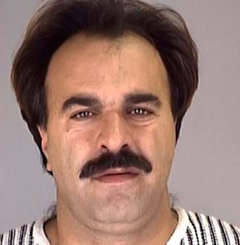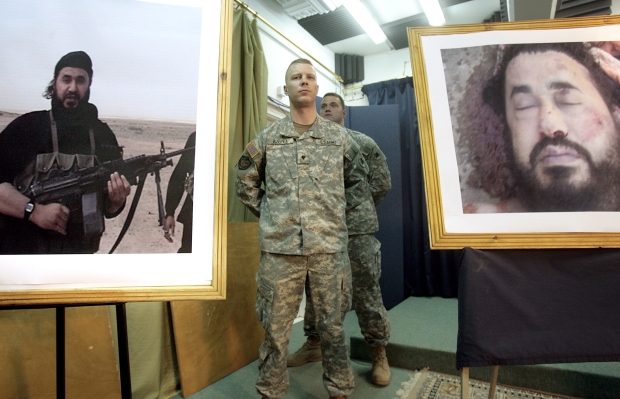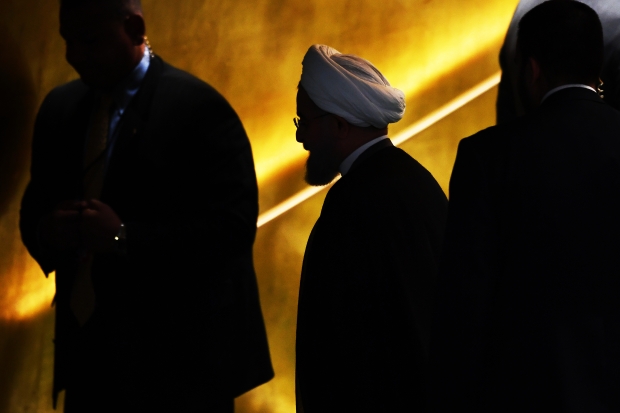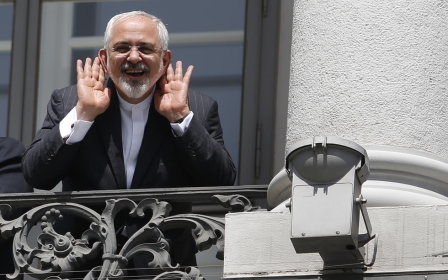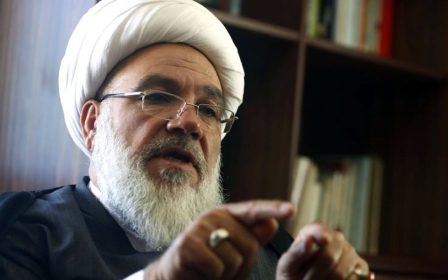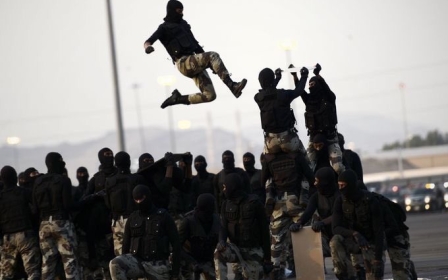
Proxies and politics: Why Iran funds foreign militias
At a military parade commemorating the 36th anniversary of the Iran-Iraq War, the chief of the Iranian armed forces spoke clearly and bluntly. Tehran holds sway over five Arab countries.
Major General Mohammed Bagheri listed them as Lebanon, Yemen, Palestine, Syria, and Iraq.
Their enemy, as Foreign Minister Mohammad Javad Zarif controversially wrote in the New York Times last month, is Wahhabism, the ultraorthodox brand of Sunni Islam propagated by Saudi Arabia.
In some of these countries, like Lebanon, Iran has a long history. In others, such as Yemen, they have only recently involved themselves. The Palestinian cause, and by extension enmity to Israel, is a cornerstone of the theocratic regime’s domestic legitimacy.
In recent years, however, it has been Syria and Iraq that have dominated global headlines and Iranian foreign policy. Damascus and Baghdad, historically the twin capitals of the Sunni Islamic caliphate, are now under the control of predominately Shia Iran – a twist not lost on large swathes of the local population.
The sectarian dimension of Iran’s involvement in Syria’s civil war is hard to ignore. Late last month, the leader of the Iraqi Shia Najbaa Movement visited Aleppo. In a propaganda video released after his visit, a song can be heard in the background with the chorus “Aleppo is Shia.”
At the time of publication, over 10,000 Shia troops are currently massing outside rebel-held east Aleppo as joint Syrian-Russian airstrikes have all but obliterated it.
Translation: "The leader of the Iraqi Shia Najbaa Movement visits the city of Aleppo"
What unites Iran’s foreign policy in all these countries, and across the decades since the 1979 Islamic revolution, is Tehran’s unwavering support for these foreign militias and non-state actors across the Middle East.
The question is: Why?
Messianism or nationalism?
A declassified CIA report, written in 1986, said that while Tehran’s support for non-state actors abroad was meant to further its national interest, it also stemmed from the belief that “it has a religious duty to export its Islamic revolution and to wage, by whatever means, a constant struggle against the perceived oppressor states.”
The messianic nature of Iran’s ruling ideology is often cited as an explanation for Iran’s support of foreign groups, with the preamble to its constitution famously committing it to “the establishment of a universal holy government and the downfall of all others.”
There has been a long-running debate over whether Iran’s support for foreign groups is rooted in national interest or in ideology.
“I think it’s very easy to latch on to this ideological concept of exporting the revolution as a justification or explanation for Iran’s policies,” Dr Sanam Vakil, an associate fellow at Chatham House, told MEE.
“It’s more about the pragmatic element,” she said. “It’s about the national interest.”
Ellie Geranmayeh, a policy fellow at the European Council on Foreign Relations, agreed: “Iran is not doing this out of an ideological zeal.”
Geranmayeh said Iran’s policy in the region has much more to do with national security policy “rather than any sort of large ambition to export revolutionary ideals across the region.”
She pointed to the fact that many of Iran’s predominately Shia citizens would not religiously associate Assad’s Alawite regime with their own religion.
Regional intervention
This has not prevented Iran from throwing the kitchen sink at the Syrian civil war to preserve its sphere of influence, even recruiting poorer Shia from countries as far away as Côte d’Ivoire, Yemen, Afghanistan and Pakistan to fight on their behalf in Syria. This is in addition to the roles of the Islamic Revolutionary Guards Corps (IRGC) and its elite branch, the Quds Force.
Hezbollah was reticent to involve themselves at first. Their involvement is still a point of controversy in the movement, with former leader Subhi al-Tufayli recently slamming their “aggression” in Syria and labelling anyone fighting alongside the Russians, or Americans, as an “enemy” to God.
“Iran has nurtured and maybe even given birth to Hezbollah, but as any parent will tell you children don’t always listen to you over the course of their life,” Vakil said.
Its leader, Hassan Nasrallah, reportedly only agreed after receiving a personal appeal from Khamenei.
“Hezbollah is not necessarily a puppet of Iran as described in the media, even though a large part of the funding comes from Iran. It has a lot of domestic goals and considerations inside Lebanon which are very important for the success of the movement,” Geneive Abdo, a senior policy fellow at the Atlantic Council, told Middle East Eye.
“Neither are the Shia militias in Iraq,” she added, some of which are more loyal to the influential Iraqi Shia cleric Ali al-Sistani than to Iranian Supreme Leader Ali al-Khameini.
“It’s very complicated,” Abdo said. “At the same time that Iran or the revolutionary guards have a great influence on these forces, it doesn’t necessarily mean they control them 100 per cent."
Vakil expresses a similar level of caution: “Saying that Iran is responsible for everything is demeaning on so many levels.”
“Iran has influence, it has money, but it doesn’t have total control of every situation,” she said. “It is important not to overstate Iran’s ability to manage everything. I think that there’s a lot of overstating and as a result everyone assumes that Iran is bigger than it is, more powerful and more influential than it is.
“That in effect plays into the hands of the IRGC and Qassem Soleimani and creates this sort of mythic impression around the region of what’s happening,” she added.
Relations between Hamas and Iran deteriorated sharply following the outbreak of the Syrian revolution in 2011. The following year, the group’s leadership left Damascus after being based there for more than a decade. Their funding was reduced drastically shortly thereafter.
“Our position on Syria affected relations with Iran. Its support for us never stopped, but the amounts [of money] were significantly reduced,” a senior Hamas official said in 2013.
In response to this turn of events, Iran ramped up funding for other Palestinian groups, most notably the Palestinian Islamic Jihad.
Iran’s heightened involvement in the Middle East “began in Iraq with the US invasion and the United States’s role in creating a Shia-led government in Iraq,” according to Abdo.
“That paved the way for Iran’s involvement beginning in 2003 not only in Iraq but now we see in other Arab countries,” she said.
For example, the Quds Force have reportedly been arming the Houthis since 2012. In 2013, the Yemeni coast guard intercepted a boat full of arms, explosives, and anti-aircraft missiles suspected to have come from Iran.
In January 2014, the Bahraini authorities also intercepted a boat departing from Iraq with more than 220 pounds of explosives and other weapons such as C-4 explosives, mines and grenades.
Legacy of the Iran-Iraq war
Any analysis of Iran’s role in Iraq, and indeed the wider Middle East, must include reference to Iran’s bloody, eight-year long war with Saddam Hussein’s Iraq.
Geranmayeh emphasised the autonomy of the local actors themselves: “Given the near and imminent fall of Baghdad in 2014, Iran offered its help to Baghdad and that help was legitimately accepted by the central government of Baghdad.”
She sees Iran’s experience in the Iran-Iraq war as crucial to Iran’s approach to foreign militias around the Middle East in general, and Iraq in particular: “The (Iranian) military was weakened during the eight-year war with Saddam Hussein and so a kind of more voluntarily, locally organised Basij paramilitary force emerged in Iran. A lot of people who are in the Iranian military have that experience themselves of the Iran-Iraq war of how to mobilise local operations into a security architecture in times of need and in times where there is essentially a security vacuum in place. So they have certainly transported some of that know-how into Iraq.”
She says that a similar dynamic is at play in Syria and the pro-government National Defence Forces (NDF): “What they (Iran) would say with the NDF is that they are in Syria with the legitimately recognised, UN-recognised government of Syria, the Assad regime, having blessed their cooperation in the Syrian sphere. They would see their role as advisory on the ground to local groups fighting at a time essentially when there is a security vacuum.”
“The IRGC has always played a critical role in Iran’s foreign policy,” Geranmayeh continued. “They have a long history, [with] a lot of these people of course fighting in the Iran-Iraq war, they understand the neighbouring countries very well because they spent a lot of time in those countries.”
“They (the IRGC) are most well-known for their defence of Iran during the Iran-Iraq war and the translation of that defence into supporting non-state actors in other countries throughout the world and in the Middle East itself; Hezbollah being their baby, they have created it,” Vakil said. “It’s the same sort of concept in Syria, they are responsible for the Syria portfolio, and they are responsible for any of the other portfolios around the region.”
The rise of the fiercely anti-Shia Islamic State group has increased the IRGC’s domestic popularity in recent years, Geranmayeh claims: “The IRGC is viewed much more now as a security apparatus that is protecting Iran from being contaminated by ISIS fighters… in Syria, for example, the choice is seen as one between Assad or ISIS.”
Abdo emphasised that the IRGC are an “an economic force, they’re a political force, and they’re an ideological force."
“We have to be specific, it’s the revolutionary guards who are controlling and funding the militias,” she said.
Follow the money
Iran is one of only three countries considered an official state sponsor of terror by the US; it was added to the State Department’s list on 19 January, 1984. The only other countries listed are Sudan and Syria.
The US foreign ministry’s 2013 Country Reports on Terrorism stated that Iran supports non-state actors in Lebanon, Palestine, Syria, Yemen, Bahrain and Iraq.
“I think that an opportunity has been opened for Iran in the Arab world,” Abdo said. “For many decades, Iran didn’t have the opportunity that it has now in the Arab world… It’s a result of the post-Arab uprising era.”
Naame Shaam, an independent campaign group focused on Iran’s role in Syria, published a report in December 2015 in which they estimated the level of support Iran provided non-state actors across the region.
This is a difficult task to say the least, according to Vakil.
“The key is that we just don’t know what those figures are, they’re estimates and guestimates from different sources and outlets,” she said. “The accurate reflection of Iran’s investment in Syria is a big question ultimately. We know it’s a lot but we just don’t know how much it is. And because they’ve invested a lot obviously it’s a clear indication that this strategy means something for them and they have some sort of long-term plan. But, again, there is a lot of opacity as to what that could be.”
With this in mind, Naame Shaam – comprised of Iranian, Syrian, and Lebanese activists and journalists – used publicly available data to make the following estimates:
- Lebanon: From the 1980s to the beginning of the Arab Spring, Hezbollah received between $100m and $200m annually from Iran. Domestic economic decline and the increasing intervention in Syria led to this number between being cut to around $50m to $100m per year from 2010 onwards.
- Iraq: From the 2003 invasion of Iraq until the end of Bush’s presidency, Iran provided a range of Iraqi Shia militias with $10m to $35m a year, a number which skyrocketed after 2009 to $100m to $200m a year.
- Palestine: From its consolidation of power in 2007 to the start of the Arab Spring in Syria and elsewhere in 2011, Hamas received approximately $100m to $250m per year from Iran. Hamas’s refusal to back Assad led to a dramatic decline in funding.
- Yemen: The Houthis have received anywhere between $10m and $25m a year since 2010.
- Syria: Assad government forces and its allied militias received between $15bn and $25bn over the first five years of the conflict, amounting to between $3bn and $5bn per year.
- Overall: Naame Sham estimated that over the period of time mentioned above, Iranian expenditure on foreign militias and non-state actors ranges between a low estimate of $20 billion – and a high estimate of $80 billion.
The money comes partly from public budgets, but largely from the huge sums of money under the direct control of the supreme leader and the IRGC. These funds come from clandestine business networks pumping out billions of dollars of revenue, and are untraceable as they are not accountable to the public, according to Naame Shaam.
History and consistency
Iran’s defence minister is Hossein Dehghan – a former militia commander who orchestrated the bombing of a US Marine barracks in Beirut in 1983, an attack that killed 241 American troops. This was the deadliest terrorist attack in US history before 9/11. Fifty-eight French soldiers were also killed in the same operation on a French military barracks.
The following year saw Hezbollah’s abduction of CIA station chief William Francis Buckley, who was tortured and executed.
In 1992, the Israeli embassy in Argentina was bombed, killing 29 people. Two years later a Jewish cultural centre was bombed in Buenos Aires, killing 85 people.
Iran and its Lebanese proxies were linked to both attacks. Argentina ordered the arrest of infamous Hezbollah commander Imad Mughniyah for his participation in the 1992 attack, as well as Ali Akbar Velayati, a senior adviser to Khamenei, for orchestrating the latter attack.
In 1996, a further 19 US soldiers were killed by an Iran-backed group, this time in Saudi Arabia as a result of the Khobar Towers bombing. Ahmed al-Mughassil, the suspected mastermind of the attack, was arrested last year in Beirut, having lived under Hezbollah’s protection since the attack.
Iran’s reach is not limited to the Arab world either. Its Shia majority, but staunchly secular, neighbour Azerbaijan has also felt the long reach of Tehran’s arm.
In 2006, Baku arrested 15 of its citizens with links to Iran and Hezbollah, who were planning a wave of attacks against Israeli and Western visitors in the country.
Two years later, Azerbaijan foiled a joint Iran-Hezbollah plan to bomb the country’s Israeli embassy in revenge for the 2008 assassination of Mughniyah.
In 2012, Baku carried out another wave of arrests to prevent another planned bombing campaign, again found to be linked to Iran and Hezbollah.
The same year saw five Israelis killed in Bulgaria in an attack that Sofia said had “obvious links” to Hezbollah.
In his 2014 testimony to the US House Committee on Foreign Affairs, Dr Matthew Levitt of the Washington Institute for Near East Policy said the Quds Force's increase in activities goes back to Hezbollah’s repeated failures to avenge the assassination of Mughniyah in Azerbaijan and elsewhere, leading to growing frustration within IRGC ranks.
“The IRGC would no longer rely solely on Hezbollah to carry out terrorist attacks abroad,” he told the committee. “It would now deploy Quds Force operatives to do so on their own, not just as logisticians supporting Hezbollah hit men.”
For these reasons, the State Department reported in 2012 “a marked resurgence of Iran’s state sponsorship of terrorism, through its Islamic Revolutionary Guard Corps-Quds Force (IRGC-QF), its Ministry of Intelligence and Security (MOIS), and Tehran’s ally Hezbollah. Iran and Hezbollah’s terrorist activity has reached a tempo unseen since the 1990s.”
The previous year, Iran even tried to assassinate the Saudi ambassador to the United States, Adel al-Jubeir, in the nation’s capital Washington, D.C.
Manssor Arbabsiar, an Iranian-American citizen, pleaded guilty to the plot in June 2013 and admitted to “conspiring with members of the Iranian military in the formulation of the plot,” CNN reported at the time.
Iran vehemently denied involvement, but the plot was allegedly foiled when Arbabsiar's contact in the Mexican drug cartel he tried to recruit to carry out the assassination turned out to be an undercover US agent.
Al-Qaeda connections
Iranian tensions with America only heightened after the 11 September attacks in 2001.
As the executive and legislative branches in America struggled over whether to allow families of 9/11 victims to sue Saudi Arabia, Iran’s role has also been a point of controversy.
Iran quickly condemned the terrorist attack, but the 9/11 Commission Report, published three years after the attack, found that eight of the 10 hijackers travelled through Iran between late 2000 and early 2001.
They were taking advantage of an agreement with the Iranian government that meant the passports of al-Qaeda members were not stamped as they passed through the country.
In a similar vein, a leading figure of al-Qaeda in Iraq – Abu Musab al-Zarqawi – was given shelter in Iran in 2001 and 2002, with Tehran reportedly refusing to extradite him to Jordan. The links are said to have continued and in 2012, the US Department of the Treasury slammed the Iran's main intelligence organisation, the Ministry of Intelligence and Security (MOIS), for its “support to terrorist groups, such as al-Qaeda and al-Qaeda in Iraq... again exposing the extent of Iran’s sponsorship of terrorism as a matter of Iran’s state policy.”
In July, the US Treasury imposed sanctions on three senior al-Qaeda members – all of whom are located in Iran. Faisal al-Khalidi is a former al-Qaeda commander and plays a leading role in weapons acquisition, while veteran member Yisra Bayumi served as a mediator with Iranian authorities as early as 2015 and facilitated the transfer of al-Qaeda funds, and Abu Bakr Ghumayn in 2015 assumed control of the financing and organisation of al-Qaeda members in Iran.
With regards to Iran sheltering al-Qaeda members, Vakil said Tehran was “perhaps using them as bargaining chips.”
“There is very limited love between Iran and al-Qaeda, they have no ideological symmetry in just about anything,” she said. “If they are doing anything, it is quite a pragmatic effort trying to get something out of it and that is what this regime is known for.”
Rouhani and the regime
Hassan Rouhani has often been portrayed as a moderate, at least in comparison to his hard-line predecessor Mahmoud Ahmadinejad. His focus is said to be on rebuilding Iran’s shattered economy and normalising relations with the West.
Experts agree, however, that his impact on foreign policy has been minimal.
“It’s very difficult for one person alone to fundamentally redirect and rearrange regional policy without a consensus being formed at top leadership level,” Geranmayeh said.
Vakil agrees: “Rouhani doesn’t actually have that much control and influence over Iran’s foreign policy portfolio."
“One would assume the president is in charge of these things, but in fact he’s not,” she added. “The purview of foreign policy is primarily in the hands of the supreme leader.”
“I think his impact has been minimal,” Abdo said of Rouhani and Iran’s foreign policy. “I think that he has been used as an instrument in the similar way that Mohammed Khatami was used an instrument to achieve a certain regime objective. In Rouhani’s case it was the nuclear deal, in Khatami’s case, it was to try to improve relations with the West.”
Through this prism, the nuclear deal was not “necessarily a Rouhani victory,” she said, but what the supreme leader authorised.
Nuclear deal
In 2006, then Secretary of State Condoleezza Rice said: "Iran has been the country that has been in many ways a kind of central banker for terrorism in important regions.”
A decade later, Obama’s nuclear deal meant Iran received more than $100bn in sanctions relief as well as reintegration into the pivotal SWIFT international banking system. Rouhani has also made a number of visits to the West to increase economic ties.
The lifting of financial sanctions is a contentious issue, so much so that when the Obama administration sent $400m in cash to Iran last month, he kept his own military out of the loop.
“There was a lot of opposition to the lifting of sanctions on Iran, particularly in the US, based on the argument that the money is going to be funnelled to fund Iran’s regional policies that are essentially opposed to Western interests,” Geranmayeh said of opponents of the nuclear deal.
This was certainly the position of Naame Shaam, who wrote in the conclusion to their report that: “There have been fears that, next to domestic investment needs, part of the released funds could end up fuelling conflicts in the Middle East even further due to increased military spending and financial backing of allied militias and governments like the Assad regime in Syria.
“The increase in Iran’s 2015/16 current defence budget may be a first sign of this,” it continued. “In recent months, Ayatollah Ali Khamenei and the Iranian Minister of Defence, Hossein Dehqan, both made it clear that they had no intention to cut their support to Hezbollah, Hamas, the (Palestinian) Islamic Jihad, the Houthi militias in Yemen, the Syrian and Iraqi governments and their militias, despite a nuclear deal.”
Geranmayeh takes a different view, however: “The majority of the money is going to fund local investment projects to reduce unemployment, to promote job growth, and to tackle issues to do with inflation.”
Vakil agrees: “The country does need the money internally because if Iran is going to hit all of its growth markers for the next 10 years there has to be a lot of investment in the Iranian economy. For the Iranian regime that is a huge part of why it signed the nuclear deal. It wasn’t about anything else except the economy, and trying to get the economy going, and trying to generate foreign and internal investment into different sections of the Iranian economy. It’s about the long-term sustainability of the Islamic republic.”
The consensus is far from unanimous though.
“I think the money will be directed toward non-state actors abroad,” Abdo said. “I think that it’s very unfortunate, but I think that the regime’s strategy is that they will basically maintain the minimum economic commitment required to prevent dissent and uprising, and as long as they can maintain this low level of service to their own people – which means that the subsidies are cut and the value of the currency is low and so forth – they will continue to do this if this means freeing up resources for regional domination."
“It’s very clear if you go to Iran, the wages are low, the economy is in a bad situation,” she said. “But they’re spending enormous amounts of money on their regional ambitions.”
Sectarianism and survival
Iran supports non-state actors in the Middle East “because they want to have a foothold politically in the Arab world,” Abdo said.
“I think also there is a religious dimension to this and many people disagree with me,” she said. The topic is one she discusses at greater length in her new book, The New Sectarianism, due to be published on 1 December 2016.
“If you go back and look at Khamenei’s speeches during the early years of the Arab uprising, he talked a lot about the Islamic awakening. This is just pure rhetoric,” she said. “In fact what has happened is that the Iranians are supporting Shia groups in the Arab world.”
“Nasrallah has made very clear over the last two years that Hezbollah now functions as a Shia militia,” Abdo said. “Both Iran and Hezbollah never played the Shia card, they never said that they are the military force for Shia in the region, but they departed from that approximately two years ago and now there is no question that both Hezbollah and Iran are military forces to support Shia in the region.”
“This is what I think is very important in what has changed their historic rhetoric since the revolution,” she said.
There is an ethnic, as well as a religious, dimension to the complexity of Iran’s support for foreign militias, Abdo continued, because these groups are comprised mainly of Arab, not Persian, Shia.
“The Iranians are making inroads because the Shia in many of these countries are not gaining any support from their own governments,” she said. “Iraq is a perfect example of this.”
Zarif’s article in the New York Times has refocused attention on this sectarian proxy war currently raging across the Middle East.
“No doubt the Saudis are definitely instrumental in driving this conflict, but I think the important difference is that ideologically the Saudis don’t need this conflict for their survival,” she says. “The Iranian state depends upon conflict with the West ideologically and conflict with its neighbours to maintain its survival and its legitimacy.”
This article is available in French on Middle East Eye French edition.
Middle East Eye propose une couverture et une analyse indépendantes et incomparables du Moyen-Orient, de l’Afrique du Nord et d’autres régions du monde. Pour en savoir plus sur la reprise de ce contenu et les frais qui s’appliquent, veuillez remplir ce formulaire [en anglais]. Pour en savoir plus sur MEE, cliquez ici [en anglais].




